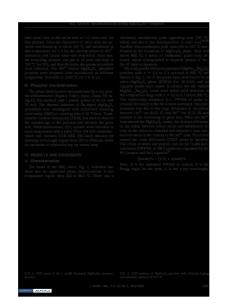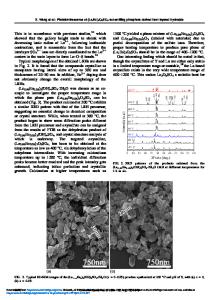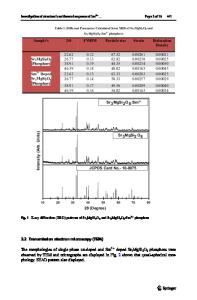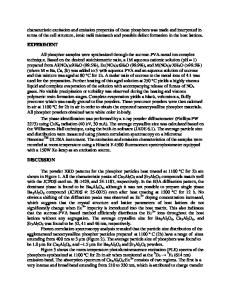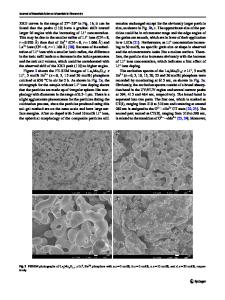Synthesis and Red Emission of Eu 3+ -DOPED NaLaMo 2 O 8 Phosphors
- PDF / 797,607 Bytes
- 5 Pages / 594 x 792 pts Page_size
- 8 Downloads / 314 Views
Journal of Applied Spectroscopy, Vol. 87, No. 4, September, 2020 (Russian Original Vol. 87, No. 4, July–August, 2020)
SYNTHESIS AND RED EMISSION OF Eu3+-DOPED NaLaMo2O8 PHOSPHORS J. Sun, Q. Li* and Q. Zhou
UDC 535.37
Eu3+-doped NaLaMo2O8 phosphors were synthesized by a conventional solid-state reaction. The phase and luminescent properties of the synthesized phosphors were investigated in the current work. In NaLaMo2O8, Eu3+ ions replace La3+ ions and form solid compound. This substitution induces the 2θ angles of diffraction peaks to shift to larger values. Under excitation at 395 nm, NaLaMo2O8:Eu3+ phosphors exhibit emission bands in the range of 550– 725 nm originating from 5D0 → 7FJ transitions (J = 0, 1, 2, 3, 4) of Eu3+. The strongest emission band corresponds to the 5D0 → 7F2 transition, which indicates a site of Eu3+ without inversion symmetry in NaLaMo2O8. The Eu3+ concentration has obvious influence on the luminescent properties of NaLaMo2O8:Eu3+ phosphors. NaLaMo2O8:6 mol%Eu3+ has the strongest excitation and emission intensities. Keywords: NaLaMo2O8:Eu3+, phosphors, luminescence. Introduction. There has been a steady increase in theoretical and experimental studies of lanthanide-activated inorganic phosphors over the past decade due to an ever-increasing demand for photoluminescence and related applications, such as lighting, electronic display, lasing, anti-counterfeiting, biological labeling, and imaging [1]. The lanthanide-activated inorganic phosphors offer better photo stability and improved color performance in the form of higher monochromatic (color) purity and spatial resolution. Moreover, these inorganic phosphors present wide optical tunability over emission wavelength and lifetime, as enabled by the intra-configurational 4f–4f and inter-configurational 4f–5d transitions of lanthanides [2, 3]. In the field of white light emitting diodes (WLEDs), lanthanide-activated inorganic phosphors are widely used and they are the critical parts of WLEDs [4]. WLEDs comprising inorganic phosphors have been regarded as third-generation solidstate lighting devices due to their advantages compared with traditional incandescent and fluorescent lamps, such as high efficiency, low consumption of energy, long operating lifetime, fast switching, and low production cost [5, 6]. Compounds of the rare earth tungstate and molybdate have a long history of practical applications due to their unique luminescence properties originating from the electron transitions within the 4f shell [7]. As is known, the luminescence of doped rare earth tungstate/molybdate is one of their most important properties. They are promising candidates for WLEDs because they are good hosts for lanthanide ions and can yield white light in combination with the narrow-line emission of doped lanthanide ions. Trivalent europium ion (Eu3+) is well known as a red-emitting activator due to its 5D0 → 7FJ transitions (J = 0, 1, 2, 3, 4). In addition to the above emission bands, other emission bands originating from higher 5D levels, such as 5D1 (green)
Data Loading...
